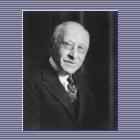President: 1908-1924
Chairman: 1924-1932
|
 "Treat people fairly and honestly and
generously and their response will be fair and
honest and generous." "Treat people fairly and honestly and
generously and their response will be fair and
honest and generous."
|
|
Julius Rosenwald was born August 12, 1862, in Springfield,
Ill. His father, Samuel, had traveled to Springfield several
years earlier to run a clothing store for his wife's family.
In 1885, Rosenwald teamed up with a cousin, Julius Weil, to
manufacture men's clothing. Coincidentally, one of the
company's clients was Richard Sears, who ordered men's clothing
for sale in his catalogs.
In 1890, Julius married Augusta Nusbaum, with whom he had
five children: Lessing, Adele, Edith, Marion and William.
Lessing served as chairman of Sears upon his father's death in
1932 until 1939.
In 1895, Rosenwald became a partner in Sears, Roebuck and Co.
when Richard Sears offered Rosenwald's brother-in-law, Aaron
Nusbaum, an interest in the company. Nusbaum recruited
Rosenwald to join the venture. In 1896, he became a vice
president of Sears, Roebuck and Co.
From the moment he joined Sears, Roebuck and Co., Rosenwald's
abilities meshed amazingly well with those of Richard Sears. He
brought a rational management philosophy to Richard Sears'
well-tuned sales instincts. From 1895 to 1907, annual sales
skyrocketed from $750,000 to $50 million. In 1908, Rosenwald was
named president when Richard Sears resigned. Rosenwald continued
to serve as president until 1924, when he became chairman of the
board, a position he held until his death in 1932.
After World War I, Sears was in dire financial shape and
Rosenwald brought Sears back from the brink of bankruptcy by
pledging some $21 million of his personal fortune, in cash,
stock and other assets to rescue the company. By 1922, Sears had
regained financial stability.
Rosenwald insisted that the company's primary goal must be
responsibility to the customer. He established the
"satisfaction guaranteed or your money back" pledge and
conducted his business dealings by the creed "Sell
honest merchandise for less money and more people will
buy." Under Rosenwald's direction, the business positioned
itself as a direct extension of the farmer's eyes, ears and
wallet, making purchasing decisions in the best interests of the
farmer.
After Rosenwald stepped down as Sears president in 1924, he
devoted most of his time to philanthropy. Over the course of his
life, he donated millions of dollars to public schools, colleges
and universities, museums, Jewish charities and black
institutions.
Of all his philanthropic efforts, Rosenwald was most famous
for the more than 5,000 "Rosenwald schools" he
established throughout the South for poor, rural black youth,
and the 4,000 libraries he added to existing schools. The
network of new public schools subsequently employed more than
14,000 teachers. In 1927, Rosenwald received a special gold
medal from the William E. Harmon Awards for Distinguished
Achievement in Race Relations for his contributions to the
education of black youth.
Rosenwald embodied the principles of modern, responsible
management and corporate citizenship. He provided the means and
the model for Sears to grow to ever-greater heights as a
company. More important, Rosenwald's life served as a blueprint
for doing everything in one's power to raise the fortunes of
those who otherwise could not do so.
|


